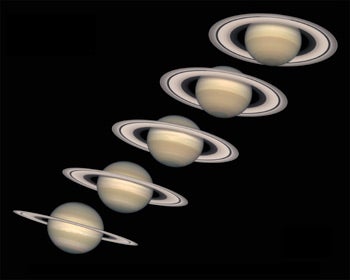The ring system is not a single ring but composed of several bands, each containing numerous ringlets. Jean Dominique Cassini first spotted the dark division splitting what astronomers now call the A and B rings, and later, faint rings were found in the Cassini Division itself. Johann Encke found another, thinner division in the A ring, which we call the Encke Gap (or Encke Division). Astronomers have since identified two rings within the B ring (closer to Saturn) called the C and D rings, and three beyond the A ring called the F, G, and E rings.
Saturn’s rings and ringlets also are not solid, but composed of tiny chunks of ice and rock. Keeping those ring particles in place are small moons which lie in the gaps between the rings. Pan lies in the Encke Gap, while Atlas and Prometheus lie between the A and F rings. Pandora guards the outside of the F ring, as Janus and Epimetheus orbit farther out, but still within the G ring. Mimas lies outside the G ring, and many more moons reside inside the wide E ring.
This activity will allow you to get a closer look at the rings and moons that make up Saturn’s gorgeous ring system. The scale of the E ring is so large (up to four Saturn diameters from the planet), that only the rings and moons inside its orbit are shown. All of the images are from NASA’s two Voyager missions, which flew past Saturn in the early 1980s. (Note: Images of Atlas, Prometheus, Janus, and Epimetheus are copyrighted by Calvin J. Hamilton.)










